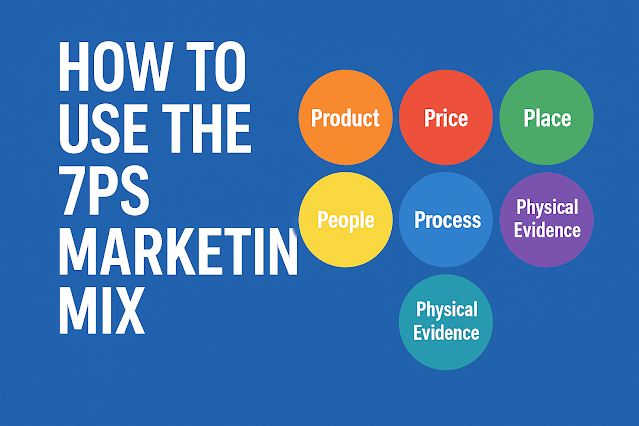How to Use the 7Ps Marketing Mix: A Complete Guide

Marketing is the
heartbeat of any business. To compete in a crowded market, companies must craft
a strong strategy that addresses customer needs while promoting their offerings
effectively. One of the most popular and comprehensive frameworks for this purpose
is the 7Ps Marketing Mix. Originally developed as the 4Ps (Product,
Price, Place, Promotion) by E. Jerome McCarthy in the 1960s, it was later
expanded to 7Ps by adding People, Process, and Physical Evidence. This article
will guide you on how to use the 7Ps marketing mix effectively in your
business strategy.
1.
Product – What Are You Offering?
Definition: The product is the actual item or service you
offer to satisfy a customer’s need or want.
How to use it:
- Understand customer needs through
research and feedback.
- Create a product with the right
features, quality, and design.
- Continuously innovate or update
your offerings based on trends and customer preferences.
- Offer variations or bundles to
appeal to different segments.
- Focus on unique selling points
(USPs) that differentiate you from competitors.
Example: Apple focuses heavily on product innovation,
sleek design, and user experience, which are core to its brand.
2.
Price – What Will the Customer Pay?
Definition: Price refers to the amount a customer must
pay to obtain the product or service.
How to use it:
- Consider costs, profit margins,
and competitor pricing when setting prices.
- Use pricing strategies such as:
- Penetration pricing to gain market share quickly.
- Skimming pricing for new or innovative products.
- Psychological pricing (e.g., $9.99 instead of
$10.00).
- Value-based pricing which focuses on perceived
value.
- Offer discounts, seasonal
pricing, or loyalty rewards to retain customers.
- Continuously review prices based
on market trends and consumer behavior.
Example: Budget airlines use dynamic pricing to
optimize seats based on demand, season, and booking time.
3.
Place – Where Will the Product Be Available?
Definition: Place refers to how and where your product or
service is distributed and made available to customers.
How to use it:
- Choose the right distribution
channels (online, retail stores, resellers, etc.).
- Optimize supply chains and
logistics for timely delivery.
- Consider the location of your
business or outlets based on target demographics.
- Expand online presence through
e-commerce platforms.
- Use third-party delivery services
or drop-shipping for wider reach.
Example: Amazon excels at place strategy by offering
fast, reliable delivery and wide product availability through its global
network.
4.
Promotion – How Will You Communicate With Customers?
Definition: Promotion involves the activities you do to
make customers aware of your product and persuade them to buy.
How to use it:
- Use a mix of promotional tools:
advertising, public relations, sales promotions, personal selling, and
digital marketing.
- Tailor messages to specific
audience segments.
- Choose the right platforms:
social media, email marketing, search engine ads, influencer partnerships,
etc.
- Offer time-limited promotions or
special deals to create urgency.
- Monitor campaign performance and
adjust based on results.
Example: Coca-Cola runs emotional and seasonal
advertising campaigns across various media to connect with audiences.
5.
People – Who Delivers the Experience?
Definition: People refer to everyone involved in
delivering your product or service, including employees, customer service, and
even customers themselves.
How to use it:
- Hire skilled, motivated, and
customer-focused employees.
- Train staff regularly on product
knowledge and soft skills.
- Encourage positive customer
interactions through incentives and feedback systems.
- Build a brand culture that aligns
with customer expectations.
- Personalize customer experiences
where possible.
Example: Starbucks invests heavily in employee
training to ensure consistent service and enhance customer satisfaction.
6.
Process – How Is the Service Delivered?
Definition: Process refers to the systems and procedures
used to create, deliver, and manage your product or service.
How to use it:
- Streamline internal processes to
ensure efficiency and quality.
- Make the buying experience smooth
and easy.
- Automate repetitive tasks where
possible (e.g., order tracking, customer service bots).
- Ensure consistency across
different touchpoints (in-store, online, mobile).
- Collect and analyze customer data
to improve workflows.
Example: Uber’s app offers a seamless process from
booking a ride to payment and feedback, creating a frictionless experience.
7.
Physical Evidence – What Proof Can Customers See?
Definition: Physical evidence includes tangible elements
that help customers evaluate and trust your product or service.
How to use it:
- Maintain clean, attractive retail
spaces or offices.
- Use high-quality packaging and
branding.
- Showcase testimonials, case
studies, certifications, or awards.
- Provide detailed product
descriptions, videos, or demos online.
- Ensure your website or app is
well-designed and user-friendly.
Example: Hotels use photos, reviews, and star ratings
on booking platforms to reassure customers about their quality and reliability.
Applying
the 7Ps Together
Each element of
the 7Ps mix works best when aligned with the others. Here's how to apply them
together in a strategy:
Step
1: Research Your Market
- Understand your customers,
competitors, and trends.
Step
2: Design Your Marketing Mix
- Create a unique combination of
the 7Ps tailored to your audience.
Step
3: Test and Measure
- Launch campaigns or new offerings
in a small segment to gather insights.
Step
4: Analyze Performance
- Use KPIs and feedback to evaluate
success and make improvements.
Step
5: Adapt and Evolve
- Update your mix based on customer
preferences, new technology, and market shifts.
Conclusion
The 7Ps marketing
mix provides a powerful structure for building and refining your business
strategy. By focusing not just on the product but also on the people,
processes, and presentation surrounding it, companies can create a complete
customer experience that drives satisfaction and loyalty.
Whether you’re a
small startup or a global brand, consistently revisiting and optimizing your
7Ps can help you stay competitive, connect with your audience, and grow your
business in today’s dynamic marketplace.











0 Comments